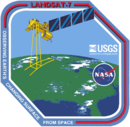
Back لاند سات 7 Arabic Landsat 7 Byelorussian Landsat 7 Catalan Landsat 7 Czech Landsat 7 Danish Landsat 7 German Landsat 7 Esperanto Landsat 7 Spanish Landsat 7 Basque لندست ۷ Persian
 Landsat 7 before launch | |
| Mission type | Satellite imagery |
|---|---|
| Operator | NASA / USGS |
| COSPAR ID | 1999-020A |
| SATCAT no. | 25682 |
| Mission duration | 5 years (planned) 25 years, 7 months (in progress) |
| Spacecraft properties | |
| Bus | TIROS-N |
| Manufacturer | Lockheed Martin Space Systems |
| Launch mass | 1973 kg |
| Dimensions | 4.04 metre long 2.74 metre diameter |
| Power | 1550 watts |
| Start of mission | |
| Launch date | 15 April 1999, 18:32:00 UTC |
| Rocket | Delta II 7920 |
| Launch site | Vandenberg, SLC-2W |
| Contractor | Boeing |
| Entered service | 1999 |
| Orbital parameters | |
| Reference system | Geocentric orbit[1] |
| Regime | Sun-synchronous orbit |
| Altitude | 705 km |
| Inclination | 98.21° |
| Period | 98.83 minutes |
| Repeat interval | 16 days |

| |
Landsat 7 is the seventh satellite of the Landsat program. Launched on 15 April 1999, Landsat 7's primary goal is to refresh the global archive of satellite photos, providing up-to-date and cloud-free images. The Landsat program is managed and operated by the United States Geological Survey, and data from Landsat 7 is collected and distributed by the USGS. The NASA WorldWind project allows 3D images from Landsat 7 and other sources to be freely navigated and viewed from any angle. The satellite's companion, Earth Observing-1, trailed by one minute and followed the same orbital characteristics, but in 2011 its fuel was depleted and EO-1's orbit began to degrade.[2] Landsat 7 was built by Lockheed Martin Space Systems.
In 2016, NASA announced it planned to attempt the first ever refueling of a live satellite by refueling Landsat 7 in 2020 with the OSAM-1 mission;[3][4][5][6] however after multiple delays, NASA announced the cancellation of OSAM-1 in March 2024.[7]
- ^ "LANDSAT 7 Satellite details 1999-020A NORAD 25682". N2YO. 25 January 2015. Retrieved 25 January 2015.
- ^ EO-1 Phase F Report
 This article incorporates text from this source, which is in the public domain.
This article incorporates text from this source, which is in the public domain.
- ^ Kleiner, Kurt (24 February 2022). "Orbiting robots could help fix and fuel satellites in space". Knowable Magazine. doi:10.1146/knowable-022422-1. Retrieved 10 March 2022.
- ^ Henshaw, Carl Glen; Glassner, Samantha; Naasz, Bo; Roberts, Brian (3 May 2022). "Grappling Spacecraft". Annual Review of Control, Robotics, and Autonomous Systems. 5: 137–159. doi:10.1146/annurev-control-042920-011106. ISSN 2573-5144. S2CID 242628083. Retrieved 10 March 2022.
- ^ "OSAM-1: Robotic Servicing Mission | NASA's Exploration & In-space Services". NASA NExIS. 3 July 2020. Archived from the original on 3 July 2020. Retrieved 3 July 2020.
 This article incorporates text from this source, which is in the public domain.
This article incorporates text from this source, which is in the public domain.
- ^ "NASA's Restore-L Mission to Refuel Landsat 7, Demonstrate Crosscutting Technologies". 23 June 2016. Retrieved 21 December 2017.
 This article incorporates text from this source, which is in the public domain.
This article incorporates text from this source, which is in the public domain.
- ^ Foust, Jeff (1 March 2024). "NASA cancels OSAM-1 satellite servicing technology mission". SpaceNews. Retrieved 2 March 2024.